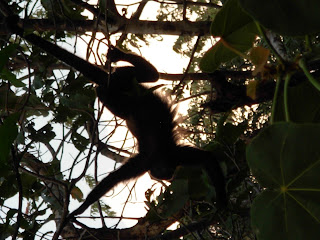Coffee Beans
Camoflouged critter at the pool...
Can you spot it?
Monkeys in the trees
We also learned a lot about Costa Rica today. The people are called "ticos" and they have inhibited the area for over 10,000 years. Back then they lived in tribes with a chief as leader. Christopher Columbus landed on the caribbean coast of Costa Rica in 1502 to repair his ship and hoped to return back when he spotted gold, but never did. Nicaragua gained independence from Spain in 1821 and Costa Rica seceded from Nicaragua in 1824 under their first head of state, Juan Fernandez. At that time they raised corn, beans, and plantains for survival and sugar, cacao, and tobacco for export. In the 19th century, the caffeinated red bean (coffee) transformed Costa Rica into the wealthiest region in Central America. More that 1/3 of the Central Valley was dedicated to coffee cultivation and it accounted for 90% of all exports. Today there are an estimated 130,000 coffee farms.
A railroad was built to transport the coffee beans to the Caribean side of Costa Rico. Bananas were grown along the railroad tracks as a cheap food source for the workers. Eventually bananas found their their way to New Orleans where the people went "bananas" over the fruit. Bananas then surpassed coffee as Costa Rica's most lucrative export by the 20th century. We have spotted truck loads of over ripe bananas and were told that they are being transported out to feed the local pigs. Can you imagine the delight that a Virginia pig would have feasting on a meal of bananas?
During the 1970's an oversupply of coffee caused the prices to crash. Big business and environmentalist teamed up to bring an import into Costa Rica: ecotourism. By 1995, there have been established more than 125 government protected sites. Almost 1/3 of the entire country is under some form of environmental protection. Tourism now has surpassed coffee and bananas as a main source of foreign currency.
In Costa Rica 75% of the population is Catholic. Every town appears to have a park near the center with a church and a school. Costa Rica provides every child with a public education and free college education. It boasts a 95% literacy rate and that is something they are proud of. They also have a free health care system for all citizens. There has not been a military here since 1949. Costa Ricans are friendly and peace loving. We are loving every minute of our visit with this country and its people.




No comments:
Post a Comment